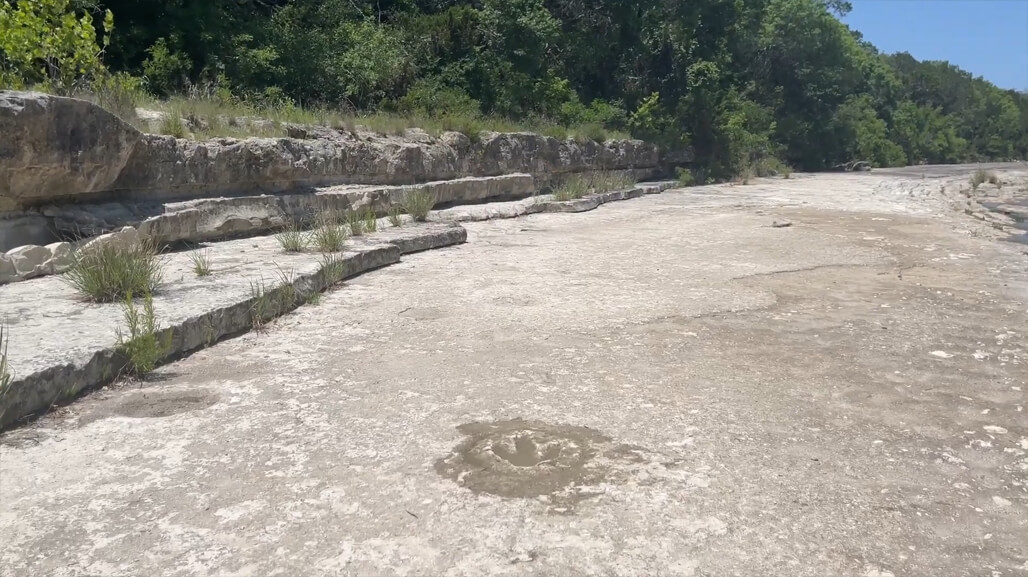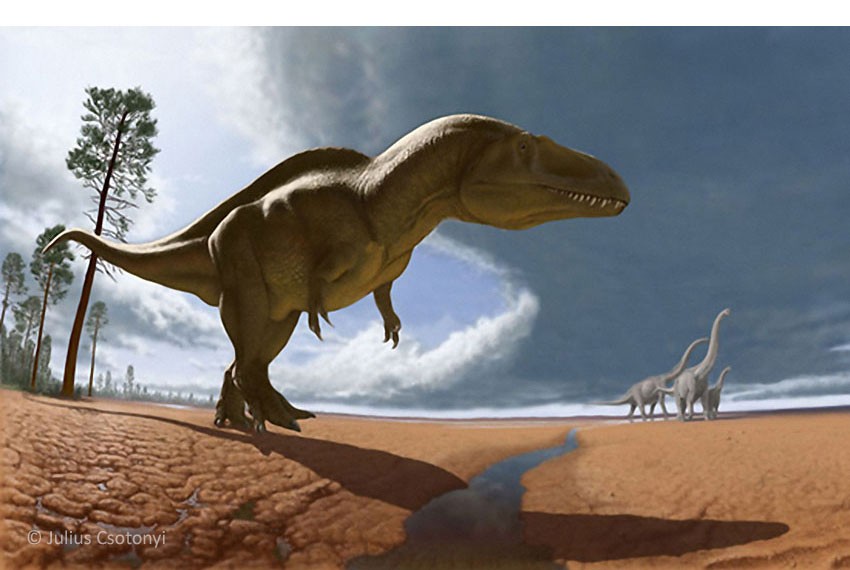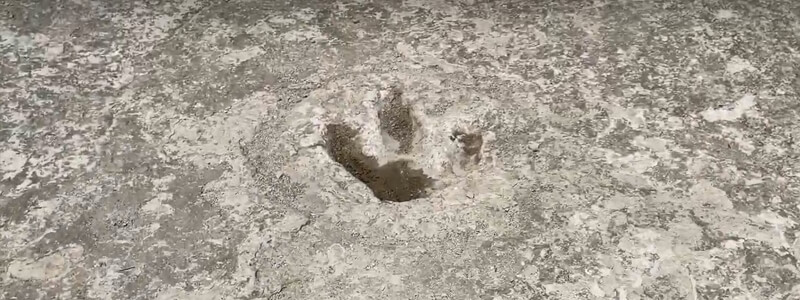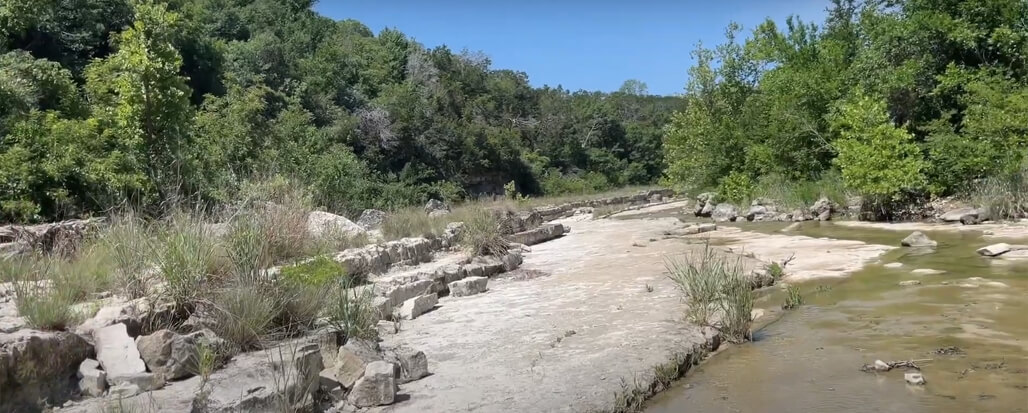Finding Dinosaur Tracks in Leander
For those who love to explore history and science, the Leander dinosaur tracks are a must-see. Located just outside of Leander, Texas, this incredible site offers a unique glimpse into the mysterious lives of dinosaurs that lived over 145 million years ago.

About a half mile west from the 183 bridge that crosses the South Fork of the San Gabriel River lies an incredible sight—dinosaur tracks embedded in the rock of the river bed. Dating back over 100 million years, these tracks are thought to have belonged to a carnivore called the Acrocanthosaurus. Though there is no official signage or fencing, visitors can still gain access to the tracks by parking either off of 183 or in the median just south of the river and trekking down to the river bed.
When at the site, it’s important to not disturb the tracks, as they could easily deteriorate over time. Visitors should also keep in mind that this spot is not a park, so don’t expect any restrooms or amenities nearby. It’s also important to remember that if there is enough rain, the river could potentially fill up and submerge the dino tracks.
The Origins of Dinosaur Tracks in Leander
The discovery of the Leander dinosaur tracks was made in 1984 by local geologist Don Corcella. While exploring the local limestone beds, he noticed several interesting imprints in the stone and soon realized they were footprints – prehistoric footprints! Little did he know that his discovery would launch a major research effort to unlock some of the mysteries of prehistory.

Scientists believe that the three-toed tracks discovered in Texas are believed to have belonged to a carnivorous dinosaur, while the round circular tracks are thought to be from a large herbivore. Some of the more defined tracks feature circles around them, likely caused by excavations conducted in early attempts to uncover the footprints.
In the late Cretaceous Period, Texas was home to several kinds of dinosaurs, including the Acrocanthosaurus. This predatory species, closely related to the famous Tyrannosaurus Rex, stood at an impressive 15 feet tall and 38 feet long. Its fossils are most often found in Texas, Oklahoma, and Wyoming, though it may have roamed all over North America.
Over time, these ancient beasts left footprints embedded in the tidal flats, which were slowly filled with clay and silt deposits from ocean tides. Eventually, these layers hardened into limestone and underwent erosion, revealing small molds of the dinosaur’s feet.
These dinosaur footprints serve as a fascinating window into a distant past, helping to shed light on the life and behavior of these animals so many years ago.
In order to understand when is the best time to locate such tracks, it’s important to keep an eye out for changes in water levels throughout the year. As these are not within a maintained park, there won’t be any designated parking or restroom facilities – so make sure to come prepared for your visit! Furthermore, it should also be noted that flash floods can occur in Texas, so if you find yourself under heavy rainfall then it’s best to turn around and head back.
Significance of the Leander Dinosaur Tracks
The Leander Dinosaur Tracks hold a significant place in the annals of paleontological history. These ancient imprints are a window into the prehistoric world, providing invaluable insights into the creatures that once roamed the lands of Texas millions of years ago.
What makes the Leander Dinosaur Tracks truly remarkable is their exceptional preservation. These tracks, dating back to the Cretaceous period, showcase the footprints of various dinosaur species, including theropods, sauropods, and ornithopods. These tracks allow researchers and enthusiasts alike to visualize the movements and behaviors of these magnificent creatures with astonishing clarity.
Not only do the Leander Dinosaur Tracks offer a glimpse into the past, but they also contribute to our understanding of dinosaur evolution. By studying the size, shape, and arrangement of the footprints, scientists can make educated deductions about the anatomy and locomotion of these ancient reptiles. Such knowledge provides crucial building blocks for reconstructing the ecological dynamics of prehistoric Texas.
Beyond their scientific significance, the Leander Dinosaur Tracks also capture the imagination of visitors and locals alike. Walking in the footsteps of these long-extinct giants elicits a sense of awe and wonder, transporting us back in time to a world vastly different from our own. It is a humbling experience that reminds us of the vastness and complexity of Earth’s history.
Preserving and studying the Leander Dinosaur Tracks is not only a testament to the rich paleontological heritage of Texas but also a tribute to the dedicated individuals and organizations working tirelessly to unlock the secrets of our prehistoric past. As we continue to delve deeper into the mysteries of these ancient imprints, we uncover more about the fascinating world that existed before us, allowing us to piece together the puzzle of life on Earth and appreciate the interconnectedness of all living beings, past and present.
Exploring the Evidence
Upon closer examination, researchers determined that the tracks belonged to two different species of dinosaurs – tritons and tyrannosaurus rex. The tracks were so well preserved that it was possible to even see evidence of skin patterns on the feet of the animals! Researchers have also been able to determine where the creatures traveled, how they interacted with each other, and even learn about their diet and daily activities.
Types of dinosaurs that left their tracks in Leander
Leander holds a hidden treasure that takes us back millions of years into the prehistoric era. The dinosaur tracks found in this area provide a fascinating glimpse into the diverse range of creatures that once roamed the ancient landscapes.
Acrocanthosaurus
Paleontologists have carefully studied and identified several types of dinosaurs that left their tracks in Leander. One of the most prominent is the Acrocanthosaurus, a massive predator known for its large spines on its back. These tracks showcase the sheer size and power of this remarkable creature, leaving us in awe of the world it once inhabited.
Dilophosaurus
In addition to the Acrocanthosaurus, other dinosaur species have also left their mark in Leander. The tracks of the Dilophosaurus, with its distinctive crests and slender build, provide evidence of the presence of this early Jurassic carnivore. These tracks allow us to imagine the swift movements and agile hunting strategies of this iconic dinosaur.
Sauroposeidon
Another intriguing discovery in Leander is the tracks of the Sauroposeidon, a colossal long-necked dinosaur that walked on four massive legs. These tracks offer a glimpse into the immense size and weight of this herbivorous giant, leaving us marveling at the sheer magnitude of its existence.
The diversity of dinosaur tracks found in Leander showcases the rich ecosystem that once thrived in this region. From fearsome predators to gentle herbivores, these tracks provide a window into the past, allowing us to piece together the intricate tapestry of life during the time of the dinosaurs.
Preserving History and Nature
The Leander dinosaur tracks site is now part of a larger nature reserve managed by the City of Leander and local conservation groups. Visitors can follow interpretive trails which explain more about the significance of the tracks and allow them to view them up close. As an added bonus, the nature reserve offers many other opportunities for exploration, such as scenic hiking trails, educational interpretive programs, and bird watching.
Visiting the Leander Dinosaur Tracks site
As you make your way to the site, anticipation builds with each step. The excitement of what awaits you is palpable. Once you arrive, you are greeted by a vast expanse of exposed limestone, revealing a treasure trove of ancient footprints left behind by dinosaurs that roamed the area millions of years ago.
Walking along the trail, you can’t help but marvel at the sheer size and intricacy of these fossilized imprints. Each step unveils a new discovery, as you spot tracks ranging from the mighty footprints of a massive therapod to the delicate imprints of a small herbivorous dinosaur. The diversity and preservation of these tracks are truly remarkable, offering a glimpse into the rich biodiversity that once thrived in this region.
Leander Dinosaur Tracks Trailhead
100 Green Valley Dr, Leander, TX 78641
For those who enjoy hands-on exploration, the site offers a unique opportunity to participate in guided tours and fossil identification workshops. Knowledgeable guides lead you through the site, sharing their expertise and helping you uncover hidden secrets within the tracks. Whether you’re a seasoned paleontologist or a curious amateur, these interactive experiences are sure to leave you with a newfound appreciation for the wonders of the past.
Conclusion
With its rich history, robust scientific research opportunities, and stunning natural beauty, there’s no doubt that the Leander dinosaur tracks are a must-see for any history, science, or nature enthusiast. So if you’re looking for an exciting adventure and a chance to uncover some prehistoric secrets, look no further than the Leander dinosaur tracks!




